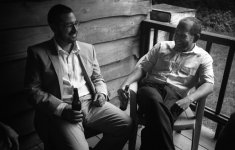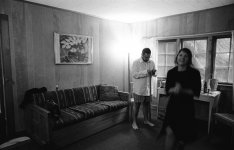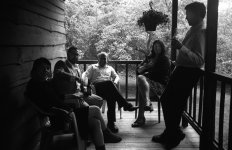Benjamin Marks
Veteran
The following is an admittedly jumbled set of recent impressions.
I recently photographed my brother's wedding with a Nikon D3, an M8 and an M6/M3 loaded with Neopan 400 bw film. I have not used much film of late, maybe 20 rolls in the last year or so, of various types. I have to say, I am just amazed at what the M8 is capable of compared to a 400 speed black and white film. For instance, the cover of the wedding album is a photograph of my brother's and sister-in-law's hands, shot with a 50 Summicron at ISO 160 on the M8. Actually, it is a crop of the frame, comprising about a 1/2 of the useful image. After conversion in Photoshop, the resulting whole image would have been larger than the largest I ever printed in 35mm b&w: 11x14; the cover of the book is 11x13 itself and the cropped image bleeds to the edge of the frame. The image is grainless/noiseless and the technical quality of the picture, the skin tones and so on, are easily equal to what I could have achieved with a medium format camera ten years ago.
I realize that it is not fair to compare absolute IQ of an ISO 160 digital image with an ISO 400 scanned film image, but in general the digital files were easier to work with, less time consuming to adjust (remember spotting prints? -- I now do this with negative scans). Where the film scans have an edge is in something I'll call "tone" -- there is a classic quality to the images that I have never been able to imitate with conversion programs (currently Alien Skin 2). Some of the wedding-preparation pictures were made with an old goggled 35 Summaron and the way that lens renders is very evocative. (Work that flare, baby.) I chose to record the wedding both digitally and on film because I want to be able to check in on the images in 30 years and cannot imagine what our digital future holds: the rate of change is too great.
Bottom line: if someone had told me ten years ago that I would be working with a digital rangefinder that could produce medium-format quality images using my existing Leica glass I would have asked them to wager a large sum that it would never happen. How wonderful to have been so wrong. BUT: I am not ready to say goodbye to film just yet. And I am sure there is room in the chest freezer for some more ISO 400 film stock.
Ben Marks
I recently photographed my brother's wedding with a Nikon D3, an M8 and an M6/M3 loaded with Neopan 400 bw film. I have not used much film of late, maybe 20 rolls in the last year or so, of various types. I have to say, I am just amazed at what the M8 is capable of compared to a 400 speed black and white film. For instance, the cover of the wedding album is a photograph of my brother's and sister-in-law's hands, shot with a 50 Summicron at ISO 160 on the M8. Actually, it is a crop of the frame, comprising about a 1/2 of the useful image. After conversion in Photoshop, the resulting whole image would have been larger than the largest I ever printed in 35mm b&w: 11x14; the cover of the book is 11x13 itself and the cropped image bleeds to the edge of the frame. The image is grainless/noiseless and the technical quality of the picture, the skin tones and so on, are easily equal to what I could have achieved with a medium format camera ten years ago.
I realize that it is not fair to compare absolute IQ of an ISO 160 digital image with an ISO 400 scanned film image, but in general the digital files were easier to work with, less time consuming to adjust (remember spotting prints? -- I now do this with negative scans). Where the film scans have an edge is in something I'll call "tone" -- there is a classic quality to the images that I have never been able to imitate with conversion programs (currently Alien Skin 2). Some of the wedding-preparation pictures were made with an old goggled 35 Summaron and the way that lens renders is very evocative. (Work that flare, baby.) I chose to record the wedding both digitally and on film because I want to be able to check in on the images in 30 years and cannot imagine what our digital future holds: the rate of change is too great.
Bottom line: if someone had told me ten years ago that I would be working with a digital rangefinder that could produce medium-format quality images using my existing Leica glass I would have asked them to wager a large sum that it would never happen. How wonderful to have been so wrong. BUT: I am not ready to say goodbye to film just yet. And I am sure there is room in the chest freezer for some more ISO 400 film stock.
Ben Marks




